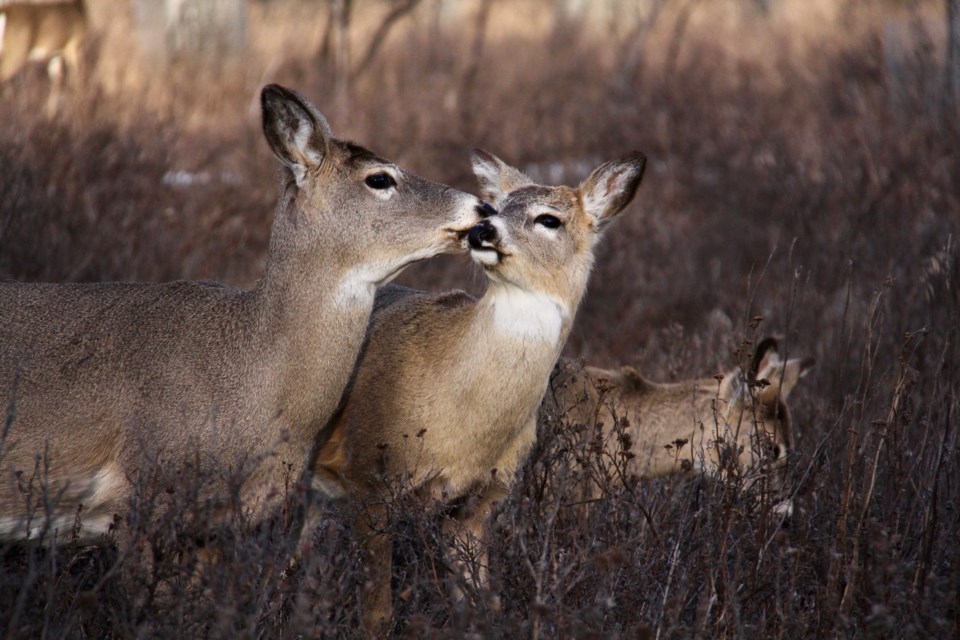Mule deer are a common site in Southern Alberta town and cities, unlike white-tailed deer.
The two species may appear similar, but according to wildlife biologist Dr. Susan Lingle, there are major differences between them that have allowed mule deer, in particular, to thrive in urban environments.
Lingle, who is a biology professor at the University of Winnipeg, has spent much of her career studying deer populations in southern Alberta.
"Most of my research has been in Alberta," she said. "I have a long-term field site on the McIntyre Ranch south of Lethbridge, where I've worked with white-tailed deer and mule deer since 1993.
"A big focus was on their responses to coyotes and how it affects their habitats and other aspects of their behaviour, their social behaviour, even things like their courtship and risk of disease transmission, because it affects their social behaviour."
Lingle, who has authored over 20 publications on deer and anti-predator responses, said the different ways the two species respond to predators is a major element of why mule deer thrive in urban environments.
"The whitetails rely more on hiding and staying concealed to avoid detection," she said, "and if they're encountered or chased, they rely on a fast gallop.
"Mule deer, they're just much more calm in temperament, and presumably this is because they're used to kind of standing their ground."
Lingle said the two species' different responses to predators, such as coyotes, translates to their different responses to humans.
"So what I mean is, the mule deer have this calmer temperament related to their anti-predator strategy because they stand their ground and kind of assess the situation," she said. "And as long as they're bunched together, the coyotes are quite intimidated and will not go forward and try to make an attack.
"Whitetails don't deter the coyotes at all. I'm not saying that whites are never aggressive, but they don't have that sort of systemic aggression, like they'll sort of run in and kind of try to hit a coyote and then they dash out of there."
Because of their different behaviours, mule deer are more inclined to become comfortable around humans, while white-tailed deer are "much more nervous animals and much more difficult to habituate."
She added that white-tailed deer are usually found in more wooded habitats, or places with cover, and mule deer tend to be on more rugged terrain.
Due to their preference for cover, white-tailed deer do not tend to thrive outside of forests and similar areas, whereas the tendency of mule deer to stand in the open helps them do well in urban settings.
White-tailed deer can be found in urban environments with large forested areas, like Calgary and Lethbridge, while mule deer occupy the more urbanized parts of those cities.
Conversations on urban deer populations in Foothills County typically revolve around mule deer due to their abundance in towns like Okotoks and Diamond Valley.
Gordon White, an urban forestry parks technician with the Town of Okotoks, has seldom seen white-tailed deer in the area since moving to Okotoks in 2007.
"I've only had two sightings during that time," said White, "and I've been keeping close tabs on the wildlife here."
The Town of Okotoks' annual deer count, which is organized by White, has not recorded white-tailed deer in the nine years it has been conducted so far.
"Mule deer are more likely to habituate," said Lingle, "and the cities or towns are really a nice refuge from predators.
"They're often accompanied by a good food source, as I'm sure you've observed."
Lingle mentioned research done by her colleague, Dr. Erin McCance, who has extensively studied urban deer populations and found a direct link between feeding deer and putting them in danger of vehicle collisions.
"She did find these hot spots of [roadkill] collisions which she was able to track to particular feeding sites."
Lingle said a house, located in Winnipeg, had been feeding about 45 deer with buckets during the winter, and that the higher rate of fatal collisions with deer in that area could be attributed to that.
"You can't really convince someone when they think they're doing a good thing by feeding these animals, and it's actually surprising how common it could be. That can certainly result in a lot of very serious consequences."



